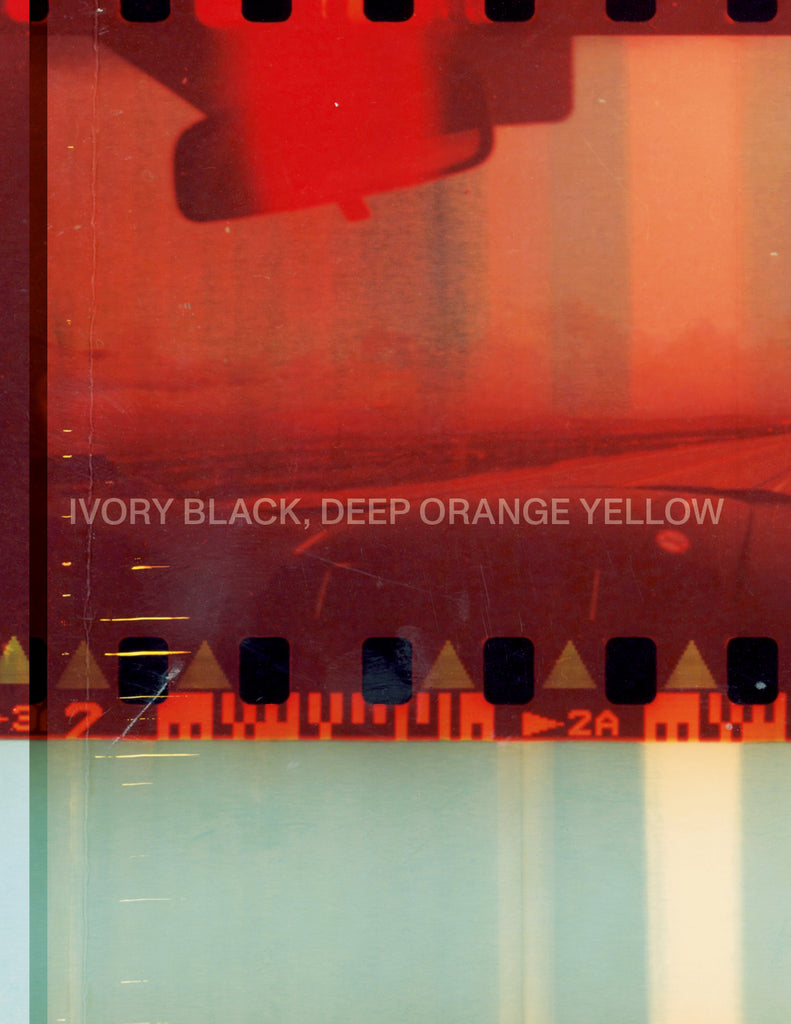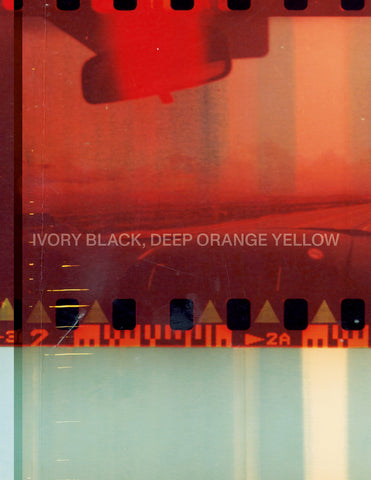Your cart is currently empty!
Ivory Black, Deep Orange Yellow. Carla Klein
++++++
+++Carla Klein+++
+++
Ivory Black, Deep Orange Yellow brings together Carla Klein's large oil paintings and the analogue photographs she takes and prints herself, which she uses as a starting point for her paintings. They depict a world of industrial sites, desert landscapes and open plains. ‘
I like worlds within worlds. Like swimming pools, airports, metro stations, highways and now these greenhouses, they are secluded areas, strange and empty.’
Her work is not painted from a photograph. In fact, she transfers not only the image onto the canvas, but also the materiality of the photograph itself. The photographic space becomes a painterly space and, as such, Klein's paintings emerge not only as reproductions but also as interpretations of the reality presented by the photographs, exploring the influence of contemporary visual aspects.
Klein searches a certain anonymity in monotonous landscapes. '
I prefer to be able to look into the distance, as far as possible'.
She explores the interplay between digital and analog mediums, probing the complexities of image creation and interpretation. Drawing from her own photos, transitioned from negative to snapshot to canvas, her landscapes take on new meanings, detached from their origins. Her works aren't reproductions but interpretations, shedding light on how contemporary visual culture shapes our perception.
The release of this extensive monograph coincides with her first solo museum exhibition in the Netherlands at KM21 in The Hague. Klein exhibited numerous times nationally as well as internationally, and has received multiple scholarships and prizes.
‘space that exists, but that you cannot reach' as described by Carla Klein. Anyone standing in front of the paintings undergoes a similar experience. In a virtuosic, figurative style, the spatiality of a landscape or city is evoked, in which you, as a viewer, want to be absorbed. But at the same time, there is the reality of the material, and this contradicts the illusion. The eye is confronted with a membrane of paint. Smudges caused by rubbing the paint and streaks of paint drips float above the illusion of the realistic landscape like an abstract layer. The painting carries multiple realities, they exist alongside each other, in each other. - Jannie Regnerus
Carla Klein (b. 1970) lives and works in Rotterdam, the Netherlands. She studied at the Royal Academy of Art, The Hague (1988-1993) and later completed a residency at the Rijkskademie in Amsterdam (1994-1995). For three decades, Klein has explored the relationship between digital and analogue photography and painting as well as the layers of mediation involved in both creating and interpreting images. Using her own photography as a point of departure, Klein’s paintings push the original image towards abstraction in ways that reveal inherent flaws in processes of representation. Enlarged from negative to snapshot, and from snapshot to canvas, her sublime landscapes become real objects, far enough removed from their subjects that they take on new and different meanings. Klein is represented by Tanya Bonakdar Gallery, New York | Los Angeles (US) and Annet Gelink Gallery, Amsterdam (NL). Her work can be found in the permanent collections of the Berkeley Art Museum, California (US); Miami Art Museum, Florida (US); National Gallery of Art, Washington, D.C (US); Georgia Museum of Art, University of Georgia (US); Museum Boijmans Van Beuningen, Rotterdam (NL); Museum MORE, Gorssel (NL); Museum Voorlinden, Wassenaar (NL); Schunck Museum, Heerlen (NL); Dordrechts Museum (NL); and Kunstmuseum Den Haag, The Hague (NL).
Jannie Regnerus (b. 1971) is a writer and visual artist. After a working period at the Rijksakademie, she had exhibitions in Amsterdam, Paris and Tokyo. As a writer, she made her debut with books about her long stays in Mongolia and Japan, and subsequently wrote four novels.
Christophe Van Gerrewey (b. 1982) is a critic, writer, and editor of De Witte Raaf and OASE. He published three novels and an essay collection, and taught at EPFL in Lausanne, among others. In spring 2024, Something Completely Different: Architecture in Belgium was published by MIT Press.
Gerrit Willems (b. 1952) is a writer and exhibition maker. He studied social sciences at the University of Utrecht and art history at Leiden University. He worked at the educational department of Kunstmuseum Den Haag (formerly known as Haags Gemeentemuseum), was conservator of ancient art and crafts at Stedelijke Musea Gouda, director of Centrum Beeldende Kunst Dordrecht, curator of art centre DordtYart and curator of modern and contemporary art at Museum Dordrecht. He has written on topics as diverse as ancient art and applied art, art theory and art policy, modern and contemporary art.
€39.95
Ivory Black, Deep Orange Yellow. Carla Klein
€39.95
Kunst / Artist books / Landschap / Nieuwe titels / Fotografie
Ivory Black, Deep Orange Yellow brings together Carla Klein's large oil paintings and the analogue photographs she takes and prints herself, which she uses as a starting point for her paintings. They depict a world of industrial sites, desert landscapes and open plains. ‘
I like worlds within worlds. Like swimming pools, airports, metro stations, highways and now these greenhouses, they are secluded areas, strange and empty.’
Her work is not painted from a photograph. In fact, she transfers not only the image onto the canvas, but also the materiality of the photograph itself. The photographic space becomes a painterly space and, as such, Klein's paintings emerge not only as reproductions but also as interpretations of the reality presented by the photographs, exploring the influence of contemporary visual aspects.
Klein searches a certain anonymity in monotonous landscapes. '
I prefer to be able to look into the distance, as far as possible'.
She explores the interplay between digital and analog mediums, probing the complexities of image creation and interpretation. Drawing from her own photos, transitioned from negative to snapshot to canvas, her landscapes take on new meanings, detached from their origins. Her works aren't reproductions but interpretations, shedding light on how contemporary visual culture shapes our perception.
The release of this extensive monograph coincides with her first solo museum exhibition in the Netherlands at KM21 in The Hague. Klein exhibited numerous times nationally as well as internationally, and has received multiple scholarships and prizes.
‘space that exists, but that you cannot reach' as described by Carla Klein. Anyone standing in front of the paintings undergoes a similar experience. In a virtuosic, figurative style, the spatiality of a landscape or city is evoked, in which you, as a viewer, want to be absorbed. But at the same time, there is the reality of the material, and this contradicts the illusion. The eye is confronted with a membrane of paint. Smudges caused by rubbing the paint and streaks of paint drips float above the illusion of the realistic landscape like an abstract layer. The painting carries multiple realities, they exist alongside each other, in each other. - Jannie Regnerus
Carla Klein (b. 1970) lives and works in Rotterdam, the Netherlands. She studied at the Royal Academy of Art, The Hague (1988-1993) and later completed a residency at the Rijkskademie in Amsterdam (1994-1995). For three decades, Klein has explored the relationship between digital and analogue photography and painting as well as the layers of mediation involved in both creating and interpreting images. Using her own photography as a point of departure, Klein’s paintings push the original image towards abstraction in ways that reveal inherent flaws in processes of representation. Enlarged from negative to snapshot, and from snapshot to canvas, her sublime landscapes become real objects, far enough removed from their subjects that they take on new and different meanings. Klein is represented by Tanya Bonakdar Gallery, New York | Los Angeles (US) and Annet Gelink Gallery, Amsterdam (NL). Her work can be found in the permanent collections of the Berkeley Art Museum, California (US); Miami Art Museum, Florida (US); National Gallery of Art, Washington, D.C (US); Georgia Museum of Art, University of Georgia (US); Museum Boijmans Van Beuningen, Rotterdam (NL); Museum MORE, Gorssel (NL); Museum Voorlinden, Wassenaar (NL); Schunck Museum, Heerlen (NL); Dordrechts Museum (NL); and Kunstmuseum Den Haag, The Hague (NL).
Jannie Regnerus (b. 1971) is a writer and visual artist. After a working period at the Rijksakademie, she had exhibitions in Amsterdam, Paris and Tokyo. As a writer, she made her debut with books about her long stays in Mongolia and Japan, and subsequently wrote four novels.
Christophe Van Gerrewey (b. 1982) is a critic, writer, and editor of De Witte Raaf and OASE. He published three novels and an essay collection, and taught at EPFL in Lausanne, among others. In spring 2024, Something Completely Different: Architecture in Belgium was published by MIT Press.
Gerrit Willems (b. 1952) is a writer and exhibition maker. He studied social sciences at the University of Utrecht and art history at Leiden University. He worked at the educational department of Kunstmuseum Den Haag (formerly known as Haags Gemeentemuseum), was conservator of ancient art and crafts at Stedelijke Musea Gouda, director of Centrum Beeldende Kunst Dordrecht, curator of art centre DordtYart and curator of modern and contemporary art at Museum Dordrecht. He has written on topics as diverse as ancient art and applied art, art theory and art policy, modern and contemporary art.

























